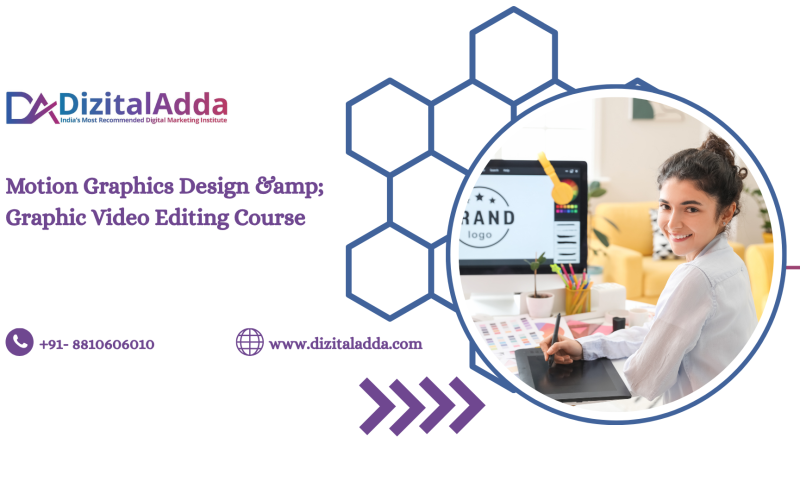Introduction
Have you ever watched a cool animation in a movie, a YouTube intro, or a flashy ad on Instagram and thought, “How do they make that?” That’s the magic of motion graphics and video editing.
If you’re someone who loves visuals, storytelling, or working with computers, then enrolling in a Motion Graphics Design & Graphic Video Editing Course could be a smart move. Not only is it fun, but it also opens up amazing career opportunities.
In this guide, we’ll explain what these courses are all about, what you’ll learn, what software tools are used, career options after completing the course, and why now is the best time to get started.
What Is Motion Graphics Design?
Motion graphics combine graphic design with animation. They are visuals that move think logos that spin, text that slides, or icons that bounce. Motion graphics are used in:
- Social media videos
- Advertisements
- Title sequences in movies
- Explainer videos
- Mobile apps and websites
Unlike traditional animation, which often tells a long story, motion graphics are more about clear communication in short time — often with cool music and effects.
What Is Graphic Video Editing?
Graphic video editing involves cutting, arranging, and enhancing video clips. But it’s more than just trimming footage — it includes:
- Adding transitions and effects
- Color grading
- Syncing audio
- Inserting graphics and text
- Creating visual stories
Good video editors bring stories to life. Whether it’s a wedding video, a product demo, or a YouTube vlog, editing can make or break the final result.
Why Take a Motion Graphics & Video Editing Course?
Still wondering if this course is for you? Let’s look at the top benefits:
1. Learn High-Demand Skills
Today, digital video content is everywhere. Brands, influencers, filmmakers, educators, and startups all need quality visuals to tell their stories. This makes motion graphics and video editing skills highly valuable.
2. Be Creative and Expressive
These skills give you the power to turn ideas into visuals. Whether it’s a product ad or a personal short film, you can bring your imagination to life.
3. Work From Anywhere
Many professionals in this field work remotely or freelance. All you need is a laptop, creativity, and the right software.
4. Career and Freelancing Opportunities
You can work as:
- Motion Graphics Designer
- Video Editor
- Visual Effects (VFX) Artist
- Content Creator
- Animation Specialist
- YouTuber or Social Media Editor
What You Will Learn in the Course
Here’s what a good motion graphics and video editing course will teach you:
1. Graphic Design Basics
- Understanding colors, fonts, and layouts
- Working with shapes and layers
- Introduction to Adobe Photoshop and Illustrator
2. Motion Graphics
- Animation principles (like bounce, squash, stretch)
- Working with Adobe After Effects
- Creating moving text, logos, and icons
- Using keyframes and transitions
- 2D and 3D motion graphics
- Exporting motion graphics for use in videos
3. Video Editing Skills
- Timeline editing techniques
- Using Adobe Premiere Pro or Final Cut Pro
- Trimming, splitting, and merging clips
- Adding titles, captions, and lower thirds
- Audio editing and background music
- Color correction and grading
4. File Handling and Formats
- Understanding video formats (MP4, MOV, AVI)
- Proper resolution for web, social media, and TV
- Exporting for YouTube, Instagram, etc.
5. Creative Storytelling
- Creating storyboards
- Editing for emotion and timing
- Adding music and sound effects for impact
6. Portfolio Development
- Real-world projects
- Showcasing your best work
- Creating a demo reel to impress employers or clients
Popular Tools You’ll Use
A strong course will train you to use industry-standard tools like:
- Adobe After Effects for motion graphics and animation
- Adobe Premiere Pro for video editing
- Adobe Illustrator for creating graphic elements
- Adobe Photoshop for image editing
- Final Cut Pro (Mac users) advanced video editing
These tools are used by professionals worldwide from YouTubers to Hollywood editors.
Who Can Take This Course?
You don’t need a design degree or advanced tech skills to start. This course is perfect for:
- Students and beginners
- Social media content creators
- Freelancers
- Marketing professionals
- Graphic designers looking to level up
- Anyone interested in storytelling through visuals
If you can use a computer and have a creative mind, you’re good to go!
Duration and Format of Courses
Most motion graphics and video editing courses come in different formats:
| Course Type | Duration | Best For |
|---|---|---|
| Short Courses | 4–8 weeks | Quick skill-building |
| Certificate Programs | 2–6 months | In-depth training + portfolio |
| Online Tutorials | Self-paced | Flexible learning for busy people |
Career Opportunities After the Course
Once you finish the course and build your portfolio, you can explore careers in:
- Advertising agencies
- Animation studios
- Television and film
- YouTube channels
- Corporate communication teams
- Freelancing platforms like Upwork and Fiverr
Salaries vary depending on experience and location. Beginners may start around $25,000–$40,000/year, while experienced designers can earn over $70,000+, or even more as freelancers with steady clients.
Tips for Succeeding in This Field
- Practice regularly. The more you create, the better you get.
- Stay updated on trends — watch ads, movie trailers, and YouTube intros.
- Join online communities to learn from others.
- Build a strong portfolio with different types of projects.
- Take feedback and keep improving.
Final Thoughts
A Motion Graphics Design & Graphic Video Editing Course is a great way to turn your creativity into a career. Whether you want to work at a top company or start your own freelance journey, the skills you learn will help you stand out in today’s visual world.
You’ll gain hands-on experience with industry tools, build real projects for your portfolio, and open doors to exciting opportunities in media, advertising, content creation, and beyond.
Don’t wait for the “perfect time.” The right time to start is now. Begin your journey into the world of motion and visuals — and let your creativity do the talking.











